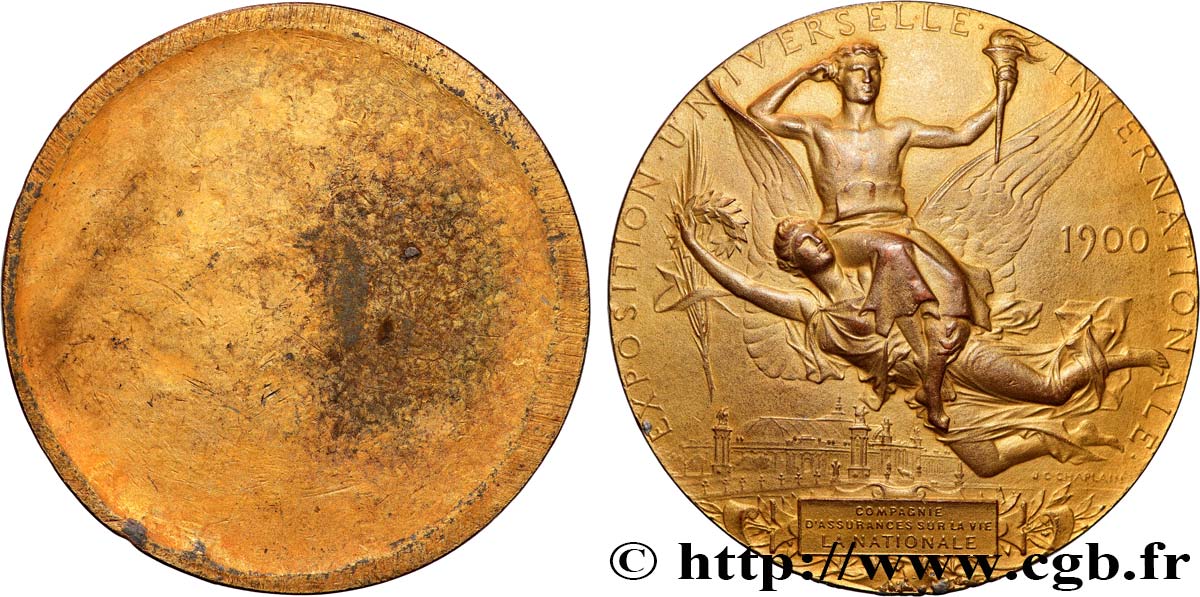fme_930085 - III REPUBLIC Médaille, Exposition Universelle Internationale, tirage uniface du revers
Not available.
Item sold on our e-shop (2024)
Price : 50.00 €
Item sold on our e-shop (2024)
Price : 50.00 €
Type : Médaille, Exposition Universelle Internationale, tirage uniface du revers
Date: 1900
Metal : gilt metal
Diameter : 63 mm
Orientation dies : 12 h.
Engraver CHAPLAIN Jules-Clément (1839-1909)
Weight : 68,11 g.
Edge : lisse
Puncheon : sans poinçon
Coments on the condition:
Médaille dorée à la patine hétérogène, présentant de l’usure sur les reliefs. Présence de coups et rayures, notamment à l’avers
Catalogue references :
Predigree :
Médaille provenant de la Collection Gailhouste
Obverse
Obverse legend : LISSE.
Reverse
Reverse legend : EXPOSITION UNIVERSELLE INTERNATIONALE / 1900 // COMPAGNIE / D’ASSURANCES SUR LA VIE / LA NATIONALE.
Reverse description : Un athlète portant la flamme, porté dans les airs par une Victoire brandissant une couronne de lauriers et une palme ; Grand Palais en arrière plan. Signé : J. C. CHAPLAIN. Cartouche timbré du nom du récipiendaire à l’exergue.
Commentary
Médaille attribuée à La Nationale.
La médaille semble être réalisée dans un alliage de plomb/étain et cuivre, doré.
L'Exposition universelle de 1900 est la cinquième Exposition universelle organisée à Paris après celle de 1855, celle de 1867, celle de 1878 et celle de 1889. Annoncée le 13 juillet 1892, elle est inaugurée le 14 avril par le président Émile Loubet, puis elle ouvre au public le 15 avril. Elle se termine le 12 novembre, après 212 jours d'ouverture. Elle accueille plus de 50 millions de visiteurs. Manifestation emblématique de la Belle Époque, dont le thème est « Le bilan d’un siècle », elle lègue à Paris plusieurs bâtiments dont le Petit Palais et le Grand Palais.
La médaille semble être réalisée dans un alliage de plomb/étain et cuivre, doré.
L'Exposition universelle de 1900 est la cinquième Exposition universelle organisée à Paris après celle de 1855, celle de 1867, celle de 1878 et celle de 1889. Annoncée le 13 juillet 1892, elle est inaugurée le 14 avril par le président Émile Loubet, puis elle ouvre au public le 15 avril. Elle se termine le 12 novembre, après 212 jours d'ouverture. Elle accueille plus de 50 millions de visiteurs. Manifestation emblématique de la Belle Époque, dont le thème est « Le bilan d’un siècle », elle lègue à Paris plusieurs bâtiments dont le Petit Palais et le Grand Palais.








 Report a mistake
Report a mistake Print the page
Print the page Share my selection
Share my selection Ask a question
Ask a question Consign / sell
Consign / sell
 Full data
Full data










